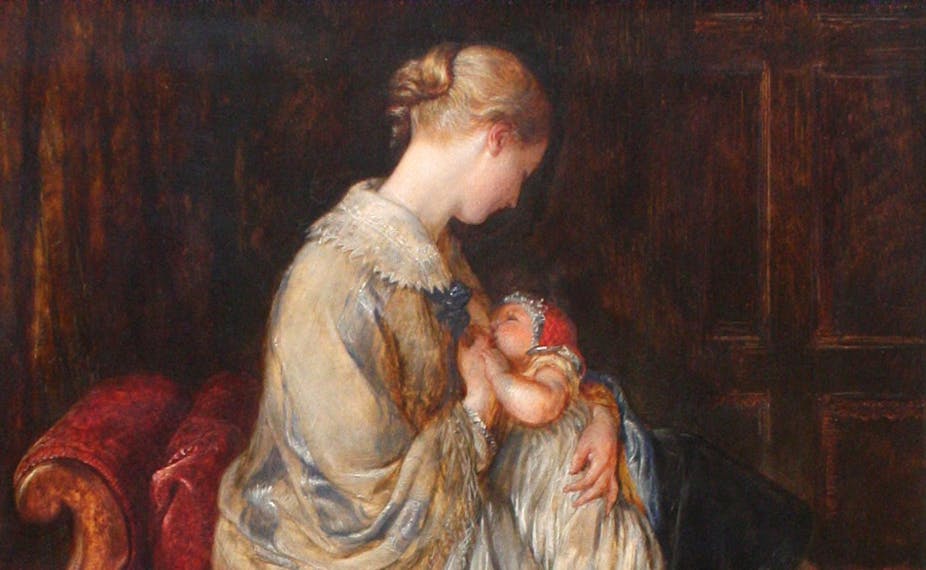New mothers face an unenviable challenge when navigating advice on how to feed infants, in a world where everyone seems to have an opinion: medical practitioners, friends, relatives, strangers in the supermarket – not to mention the daunting and potentially treacherous world of online parenting forums.
Amid an avalanche of sometimes contradictory advice, mothers often find themselves under immense pressure, terrified of getting it “wrong” and inadvertently harming their baby. This may seem like a modern phenomenon, driven by the digital age and heavily promoted ideals of motherhood in contemporary media and culture. But during Victorian times, new mothers often faced similar pressures.
Though they avoided having to navigate the likes of Mumsnet, the growing popularity of advice literature in the 19th century – coupled with rigid views on a mother’s duties and a high infant mortality rate – placed women under significant pressure to perform the role of “good mother”.
Causing a scandal
Bottle feeding grew in popularity over the course of the Victorian era, but most advice books strongly advocated maternal breastfeeding. There is some logic in this: a lack of understanding around bacteria and sterilisation meant that baby bottles were often cleaned improperly, posing a significant source of danger to infants.

This is evident in the advice of English writer and housekeeping aficionado Mrs Beeton, who suggests that “the nipple need never be removed till replaced by a new one, which will hardly be necessary oftener than once a fortnight”. Poor hygiene was one of the reasons for the higher mortality rates among bottle-fed babies in the Victorian period, though by the late 19th century, bottle feeding became much safer due to improvements in hygiene practices.
Maternal breastfeeding was not the only alternative to so-called “artificial” feeding. Wet nursing remained a relatively common practice throughout the 19th century, particularly among the upper classes. It later fell out of favour – in part due to concerns about the fate of the wet nurses’ own children. The practice of baby farming – taking in babies for money - was thought to be fuelled in part by the demand for wet nurses, who were unable to keep their own infants with them while nursing those of their employers.
One scandal in the early 1870s, which saw Margaret Waters executed for the murder of a child in her care (and suspected of murdering many more), raised ethical questions over the practice of employing wet nurses – an issue addressed by George Moore in his 1894 novel, Esther Waters.
Queen Victoria’s view
In the 19th century, Queen Victoria was among those who ignored advice to breastfeed, and instead employed a wet nurse. Indeed, she was fiercely opposed to maternal breastfeeding – believing it to be an unsuitable practice for aristocratic women – and was horrified when two of her daughters decided to breastfeed. She considered it an animal function, and, as she wrote in a letter to her daughter Princess Alice, believed the ideal wet nurse should be “like an animal” herself:
[A] child can never be as well nursed by a lady of rank and nervous and refined temperament – for the less feeling and more like an animal the wet nurse is, the better for the child.

Subsequently, in an act of “mummy-shaming” to rival anything today’s internet has to offer, Queen Victoria allegedly named a cow in the royal dairy after her daughter. It’s ironic, then, that the queen – who despised pregnancy and wasn’t overly fond of young babies (enquiring of her doctor how she might prevent her frequent pregnancies) – could possibly have benefited from the contraceptive effects of breastfeeding, had she chosen to nurse her own children.
Queen Victoria’s sentiments reflected broader attitudes among upper-class women in particular, who considered themselves too genteel to breastfeed. For instance, in her parenting advice book The Way They Should Go, English writer Jane Ellen Panton says:
I myself know of no greater misery than nursing a child […] Let no mother condemn herself to be a common or ordinary “cow” unless she has a real desire to nurse.
Panton’s sentiments were at odds with most Victorian advice literature – much of it written by medical men – which strongly advocated maternal breastfeeding, as a natural and even religious duty. The Mother’s Thorough Resource Book (1860) refers to it as “the most sacred of duties”, while Mother and Child (1868), suggests “it was beneficently ordered by the Creator that the child for a certain period after birth should be dependent on the maternal nourishment for its support”.
Elsewhere, statistical evidence was employed to encourage mothers to breastfeed, as in Infant Feeding and its Influence on Life (1860), which cites poor development outcomes for bottle feeding or spoon feeding, compared with breastfeeding.
A woman’s choice
While the origins of today’s debates over how best to feed infants lie in Victorian times, a notable difference between then and now is the modern emphasis on women’s choice. Whether advocating maternal breastfeeding, or (as in Queen Victoria’s case) the use of wet nurses, advice in the Victorian era was frequently insistent and prescriptive.
While there are some parallels to be found today – suggested by the frequent references to “lactivism” and “the breastapo” in online debates – there is also a growing acceptance of women’s choices. This is evident in the 2018 statement on infant feeding by the Royal College of Midwives, which says that “the decision of whether or not to breastfeed is a woman’s choice and must be respected”.
Today’s cult of motherhood holds striking parallels with that of the Victorians. But mothers today can take some comfort in the fact that there are now much safer alternatives to breast feeding, and that they are much more empowered to choose for themselves how best to care for their babies.

